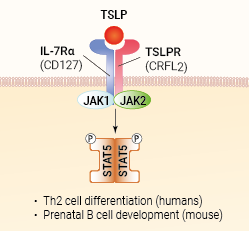Recombinant human TSLP protein - Bioactive cytokine
| Product | Unit size | Cat. code | Docs. | Qty. | Price | |
|---|---|---|---|---|---|---|
|
Recombinant human TSLP Recombinant Cytokine, source: CHO |
Show product |
10 µg 5 x 10 µg |
rcyc-htslp-hs
|
|
Human TSLP protein - Mammalian cell-expressed, His-tag, carrier-free
Recombinant human TSLP is a high-quality and biologically active cytokine, validated using proprietary TSLP reporter cells. This IL-7-like cytokine and member of the IL-2/γc superfamily is produced in CHO cells to ensure protein glycosylation and bona fide 3D structure.
Recombinant human TSLP can be used together with HEK-Blue™ TSLP cells for the screening of inhibitory molecules, such as Tezepelumab, a monoclonal antibody targeting TSLP (see figures).

TSLP signaling and biological functions
InvivoGen also offers:
Key features
- Each lot is validated using HEK-Blue™ TSLP cells
- Endotoxin ≤ 0.1 EU/µg
- 0.2 µm sterile-filtered
Applications
- Standard for TSLP detection and quantification assays
- Screening and release assays for antibodies blocking TSLP signaling
- Screening and release assays for engineered TSLP
Thymic stromal lymphopoietin (TSLP) is a critical mediator of type 2 (T2) immune responses, acting at the early stages of inflammation. Abnormal TSLP expression is linked to immune-mediated inflammation diseases, notably asthma and allergic airway inflammation.
All InvivoGen products are for internal research use only, and not for human or veterinary use.
Back to the topSpecifications
Source: Chinese hamster ovary (CHO) cells
Species: Human
Alternative name: n/a
Carrier: Carrier-free
Tag: Hexahistidine (His6)
UniProt ID: Q969D9
Protein sequence: 131 a.a. (Y29-Q159 with R127A and R130S mutations)
Molecular weight: ~ 19.9 kDa (SDS-PAGE)
Solubility: 100 μg/ml in water
Formulation: Phosphate buffer saline (pH 7.4), 5% saccharose
Sterility: 0.2 µm filtration
Form: Lyophilized
Reconstitution buffer: Endotoxin-free water (provided)
Purity: ≥93% (SDS-PAGE)
Endotoxin level: ≤ 0.1 EU/μg (measurement by kinetic chromogenic LAL assay)
Tested applications: Cellular assays
Quality control: Each lot is functionally tested and validated.
Back to the topContents
Recombinant human TSLP is provided lyophilized and is available in two quantities:
- rcyc-htslp-hs: 10 µg
- rcyc-htslp-hs-5: 5 x 10 µg
- 1.5 ml endotoxin-free water for rcyc-htslp-hs and rcyc-htslp-hs-5
![]() Recombinant hTSLP is shipped at room temperature.
Recombinant hTSLP is shipped at room temperature.
![]() Upon receipt, the product should be stored at -20°C.
Upon receipt, the product should be stored at -20°C.
![]() Avoid repeated freeze-thaw cycles.
Avoid repeated freeze-thaw cycles.
Details
Thymic stromal lymphopoietin (TSLP) is an interleukin-7 (IL-7)-like cytokine with multiple functions, including cell proliferation and survival. TSLP binds a heterodimeric transmembrane receptor comprising the shared IL-7 receptor alpha-chain (IL-7Rα, CD127) and the TLSP receptor chain (TSLPR, CRLF2), a γc-like subunit. It signals through tyrosine kinases of the Janus family (JAK1 and JAK2) and signal transducer and transcription activators (STATs), notably STAT5 [1]. TSLP is best known as a critical mediator of type 2 immune responses and a promoter of Th2 cell-mediated diseases (e.g. asthma) [1,2].
References:
1. Ebina-Shibuya R. & Leonard WJ., 2023. Role of thymic stromal lymphopoietin in allergy and beyond. Nat Rev Immunol, 23(1):24-37.
2. Schmitt P. et al., 2024. TL1A is an epithelial alarmin that cooperates with IL-33 for initiation of allergic airway inflammation. J Exp Med. 221(6) e20231236.










